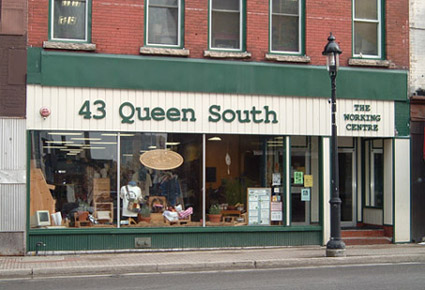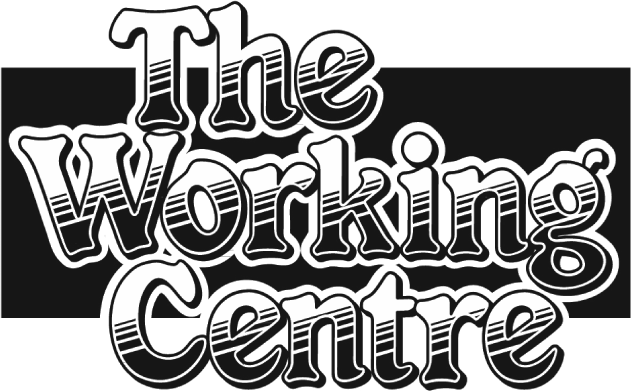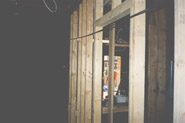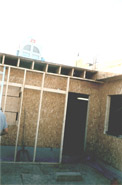By Joe Mancini, Good Work News, September 2000
 Construction work at 43 Queen St. S. has had a rhythm that is slow but purposeful. Renovating an 85-year-old building is filled with surprises and the seemingly never-ending removal of old walls to find the original structure. And a lack of experience in this area is probably normal. After all, it’s not every year that the opportunity comes along to revitalize and make new what has become old and dilapidated.
Construction work at 43 Queen St. S. has had a rhythm that is slow but purposeful. Renovating an 85-year-old building is filled with surprises and the seemingly never-ending removal of old walls to find the original structure. And a lack of experience in this area is probably normal. After all, it’s not every year that the opportunity comes along to revitalize and make new what has become old and dilapidated.
We have found that it is useless to try to move ahead quickly. Each construction detail has had to be considered from the perspective of the fire code and the building code, not to mention the effect on insulation, plumbing, heating, the sprinkler system, natural gas, electricity, venting and the roof (just to name the major protagonists). How to create occupancy on the 1st and 2nd floor when the 3rd floor is not complete? How to create apartments that conform to the building code without being able to cut out for windows on the back wall? (New windows must be off the property line by at least eight feet but the building sits on the property line on the city’s lane. The solution was to create a balcony inside the building by removing the back corner. It is a very elegant solution that can be seen walking down Charles from Frederick towards Queen.)
43 Queen Housing Initiative
The complexities and concreteness of construction are in contrast to the nature of social services. This point struck home recently as I described our 3rd floor housing project to a group of mostly social service workers. The details of actually constructing the two apartments with three bedrooms each are straightforward. How the apartments will be co-operative in nature through the sharing of the kitchen and common areas and by assisting others who find themselves without shelter is less straightforward. We expect that this will build community sometimes and resentment other times. The Working Centre is committed to helping these arrangements evolve and grow as different people move in and out of the apartments.
Perhaps my involvement in so much construction work has made it hard for me to describe the methods and support systems behind our building initiatives. In any case, no one at the meeting misread my zealous description as a formal program. For me the construction details would eventually resolve themselves into a functioning, living entity. But the blank faces in front of me were doubtless asking why there was no program attached to this project. Where was the staff and who would help these people co-operate?
The creation of housing on the 3rd floor is an innovative response to the circumstances of our everyday work and the revitalization of 43 Queen. We have calculated the expense and effort to reintegrate housing back into this building. We consider that this is the type of redevelopment that can supply housing to those with fewer housing options. It will also complement the apartments we provide at 58 Queen and our supports to people who regularly find themselves without housing.
By providing accommodation we can move people from the street to an emergency accommodation. In our plans some people will find the living circumstances to their liking and will settle in for a longer term. We will not insist on first or last month’s rent cheque. This will alleviate a barrier to finding shelter that many people encounter.
This initiative is self-supporting, as residents will live independently. One tenant per apartment will ensure that the apartments are looked after and the community/co-operative nature of the project will engender mostly good spirits. The many community projects operating out of 43 Queen will help to keep the residents involved in the daily activities of the centre.
Many circumstances leave people without shelter – an argument with a landlord, a fire, medication that goes wrong, inability to sleep in a hostel. Over time we have seen hundreds of people caught in such circumstances. We are confident that the type of shelter that we are creating will respond to such circumstances in a flexible and open manner.
Ecology in a New Light
This past spring, Toronto author Jane Jacobs, the author of several classic studies on urban development including the Death and Life of Great American Cities released a groundbreaking book, The Nature of Economies. She proposes “a radical notion of breathtaking common sense: economies are governed by the same rules as nature itself.” She does this in 150 pages using a very easy to read novel-like conversation among five friends.
One of her main points is the nature of development and expansion. Standard economic theory or the Thing Theory of development supposes that development happens when the infrastructure of factories, roads, dams and schools are present. Jacobs supposes that it is the innumerable creative acts by individuals and commercial and non-commercial organizations that co-operate together to create a diverse, sustaining economy. Things come later as a by-product.
Jacobs’ main example is of a desert or a forest. Each could exist where the other had been. Deserts are barren because the sunlight has only sand and rocks to filter through. “The passage of energy is swift, simple and vanishing, leaving no evidence of the passage.”
A forest ecosystem is completely different. It grows and expands because of the sun’s energy flowing through diverse and roundabout ways through zillions of organisms. “Once sunlight is captured in the conduit, it’s not only converted but repeatedly reconverted, combined and recombined, cycled and recycled, as energy/matter is passed from organism to organism.” A forest teems with species while a desert is comparatively barren. But if the same forest is clear-cut and the soil allowed to bake, soon you will have a desert.
Biology’s recent understanding of this phenomenon of multiple recombinations of energy passage has much to offer for understanding the way communities grow. Creative ideas are best supported by an environment where other diverse, decentralized activities are taking place. Energy needs to be co-operatively and not so co-operatively passed back and forth through numerous interdependent links. Over the years, The Working Centre has developed a small supporting web of initiatives that support people in important ways by providing access to tools, projects and other supports.
Working Centre board member, Ken Westhues calls this approach “the joy of producing for ourselves.”
“Against the ethic of mass consumerism, the Working Centre pits the ethic of ‘producerism’, drawing on thinkers like Illich, Lasch and Schumacher. It means acquiring skills and seizing opportunities to produce many of the necessities and luxuries of life on one’s own or in small groups. Unemployment from this perspective need not mean deprivation, the loss of the good life, but instead a chance to redefine the good life in a more authentic, joyful and sustainable way, in terms not so much of purchasing power as of producing power.”
Every day bikes are being fixed, reused and becoming a cheap means of getting around. People are growing food at community gardens. Every day people co-operate together to prepare and serve the meal at St. John’s Kitchen. People are getting assistance in finding a job, while others are sewing clothes and household articles. BarterWorks teaches the skills of trading and bartering as the project continues to grow and reshape itself. The new housing will create an important support in the community. Access to on-line computer training, computer recycling and community voicemail links people with new technology in a practical way that builds knowledge. These activities work as an ensemble that grows through the support they offer each other. It is like a forest with diverse interconnection.
In the midst of a great deal of activity the construction labours on. Peter, Greg and many others have contributed tremendous energy over the past year to keep the project moving and overcoming major barriers like dismantling the elevator shaft, cutting holes in the floor to create a back exit to the third floor, and cutting out the third floor back corner balcony. The housing like the bike recycling, computer recycling, computer training, community space and events, craft workshop and bartering will create a beehive of creative community services that will provide projects and tools to assist people to participate more fully in the building of community.





















